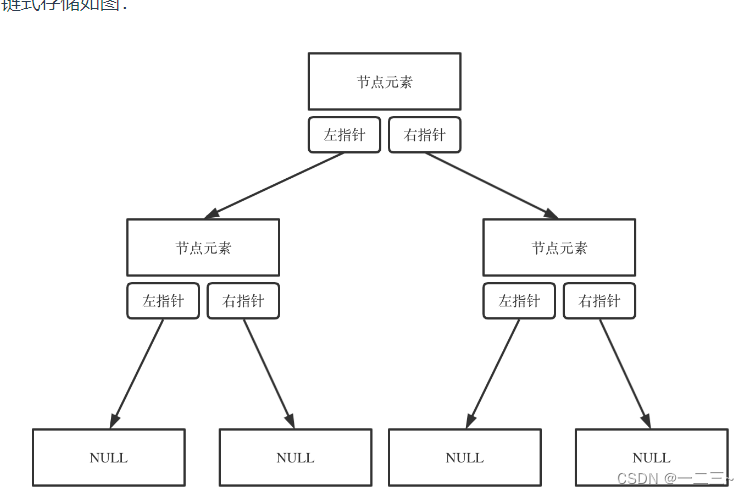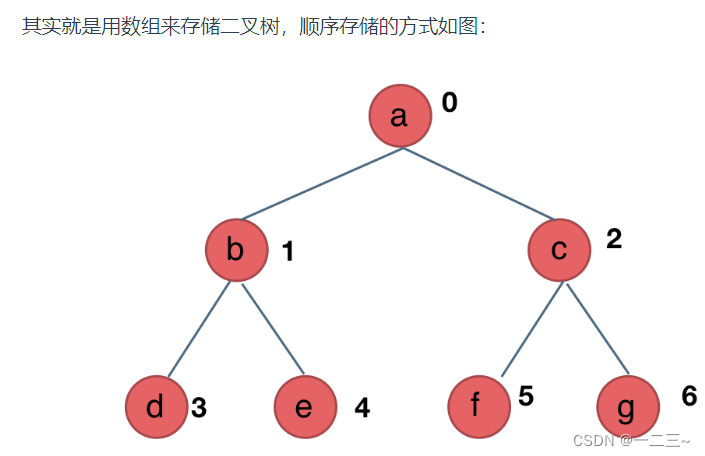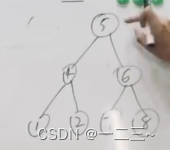理论基础
二叉树种类
满二叉树:节点数据为2^k - 1 , k 为树的深度
完全二叉树:除底层外,其他层是满的
二叉搜索树:搜索一个节点的时间复杂度为 nlogn, 节点有顺序,
左边节点都小于中间节点,右边节点都大于中间节点
平衡二叉搜索树:左子树和右子树的高度的绝对值差不超过1
存储方式
链式存储:
线性存储:

左孩子:2i + 1
右孩子:2i + 2
遍历方式
- 深度优先搜索
前序,中序,后序(一般使用递归方式,也可以使用非递归方式【迭代法】)

前序遍历:中左右【5,4,1,2,6,7,8】
中序遍历:左中右【1,4,2,5,7,6,8】
后序遍历:左右中【1,2,4,7,8,6,5】 - 广度优先搜索
层序遍历,使用队列
定义方式
public class TreeNode {
int val;
TreeNode left;
TreeNode right;
TreeNode() {}
TreeNode(int val) { this.val = val; }
TreeNode(int val, TreeNode left, TreeNode right) {
this.val = val;
this.left = left;
this.right = right;
}
}
递归遍历
力扣基础题目:144 145 94
1。 确定递归函数的参数和返回值
2。 确定终止条件
3。确定单层递归的逻辑
// 前序遍历·递归·LC144_二叉树的前序遍历
class Solution {
public List<Integer> preorderTraversal(TreeNode root) {
List<Integer> result = new ArrayList<Integer>();
preorder(root, result);
return result;
}
public void preorder(TreeNode root, List<Integer> result) {
if (root == null) {
return;
}
result.add(root.val);
preorder(root.left, result);
preorder(root.right, result);
}
}
// 中序遍历·递归·LC94_二叉树的中序遍历
class Solution {
public List<Integer> inorderTraversal(TreeNode root) {
List<Integer> res = new ArrayList<>();
inorder(root, res);
return res;
}
void inorder(TreeNode root, List<Integer> list) {
if (root == null) {
return;
}
inorder(root.left, list);
list.add(root.val); // 注意这一句
inorder(root.right, list);
}
}
// 后序遍历·递归·LC145_二叉树的后序遍历
class Solution {
public List<Integer> postorderTraversal(TreeNode root) {
List<Integer> res = new ArrayList<>();
postorder(root, res);
return res;
}
void postorder(TreeNode root, List<Integer> list) {
if (root == null) {
return;
}
postorder(root.left, list);
postorder(root.right, list);
list.add(root.val); // 注意这一句
}
}
迭代遍历
144 145 94
待理解
// 前序遍历顺序:中-左-右,入栈顺序:中-右-左
class Solution {
public List<Integer> preorderTraversal(TreeNode root) {
List<Integer> result = new ArrayList<>();
if (root == null){
return result;
}
Stack<TreeNode> stack = new Stack<>();
stack.push(root);
while (!stack.isEmpty()){
TreeNode node = stack.pop();
result.add(node.val);
if (node.right != null){
stack.push(node.right);
}
if (node.left != null){
stack.push(node.left);
}
}
return result;
}
}
// 中序遍历顺序: 左-中-右 入栈顺序: 左-右
class Solution {
public List<Integer> inorderTraversal(TreeNode root) {
List<Integer> result = new ArrayList<>();
if (root == null){
return result;
}
Stack<TreeNode> stack = new Stack<>();
TreeNode cur = root;
while (cur != null || !stack.isEmpty()){
if (cur != null){
stack.push(cur);
cur = cur.left;
}else{
cur = stack.pop();
result.add(cur.val);
cur = cur.right;
}
}
return result;
}
}
// 后序遍历顺序 左-右-中 入栈顺序:中-左-右 出栈顺序:中-右-左, 最后翻转结果
class Solution {
public List<Integer> postorderTraversal(TreeNode root) {
List<Integer> result = new ArrayList<>();
if (root == null){
return result;
}
Stack<TreeNode> stack = new Stack<>();
stack.push(root);
while (!stack.isEmpty()){
TreeNode node = stack.pop();
result.add(node.val);
if (node.left != null){
stack.push(node.left);
}
if (node.right != null){
stack.push(node.right);
}
}
Collections.reverse(result);
return result;
}
}
统一迭代
待理解








 文章介绍了二叉树的种类,包括满二叉树、完全二叉树和二叉搜索树等,以及它们的特性。同时,详细阐述了二叉树的链式存储方式和不同遍历方法,如深度优先搜索(前序、中序、后序)和广度优先搜索(层序遍历),并提供了递归和迭代的实现代码示例。
文章介绍了二叉树的种类,包括满二叉树、完全二叉树和二叉搜索树等,以及它们的特性。同时,详细阐述了二叉树的链式存储方式和不同遍历方法,如深度优先搜索(前序、中序、后序)和广度优先搜索(层序遍历),并提供了递归和迭代的实现代码示例。

















 被折叠的 条评论
为什么被折叠?
被折叠的 条评论
为什么被折叠?








